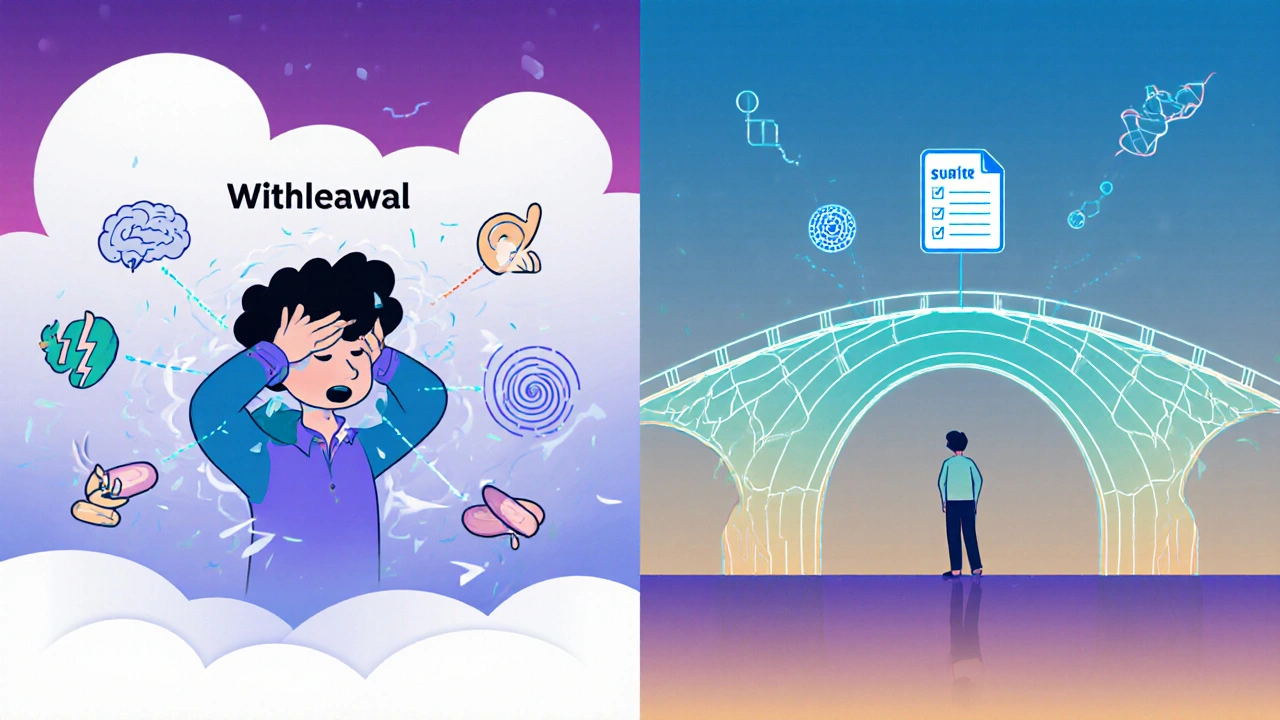Switching Medications: Proven Strategies to Reduce Side Effects and Avoid Withdrawal

Medication Switching Calculator
Select Your Medications
Choose your current medication and the new medication you're switching to to determine the safest transition method.
Recommended Switching Method
Important Notes
Critical Warning
Switching medications isn’t just a change in pills-it’s a biological reset. Your body adapts to one drug over weeks or months, and suddenly pulling it out or swapping it for another can throw your system into chaos. Brain zaps, nausea, insomnia, dizziness, even panic attacks-these aren’t random bad luck. They’re common, predictable side effects of poorly managed transitions. The good news? You don’t have to suffer through them. With the right strategy, most side effects can be minimized or avoided entirely.
Why Medication Switches Go Wrong
Most people assume switching meds is as simple as stopping one and starting another. That’s how it’s often done in busy clinics, especially when doctors are pressed for time. But that approach ignores how drugs behave in your body. Each medication has a unique half-life-the time it takes for half the dose to clear from your system. Fluoxetine (Prozac) sticks around for weeks. Paroxetine (Paxil) leaves in a day. Venlafaxine (Effexor) drops fast and can trigger withdrawal within hours. If you don’t account for these differences, you’re setting yourself up for trouble.Studies show 24% to 80% of patients experience withdrawal symptoms when stopping antidepressants abruptly. That’s not rare. That’s normal if you don’t taper. And when you jump straight to a new drug without letting the old one fully clear, you risk serotonin syndrome-a rare but dangerous condition where your brain gets flooded with too much serotonin. Symptoms include high fever, rapid heartbeat, confusion, and muscle rigidity. It’s an emergency. And it happens more often than you think during unmonitored switches.
The Four Main Switching Methods
There are four clinically proven ways to switch medications. Each has its place, depending on the drugs involved, your health history, and how your body reacts.- Direct Switch: Stop the old drug and start the new one the next day. This works best when switching between similar drugs in the same class-like from one SSRI to another. It’s fast, simple, and works for 92% of these cases. But if you’re switching from an SSRI to an SNRI or an MAOI, this method raises your risk of serotonin syndrome by 37%.
- Conservative Switch: Taper off the old drug slowly, then wait 3 to 5 half-lives before starting the new one. This is safest for drugs with long half-lives, like fluoxetine. But waiting that long means you’re off treatment for weeks. That increases your chance of relapse by 22%, which is why this method isn’t ideal for people with severe depression or anxiety.
- Moderate Switch: Taper the old drug a bit, then start the new one after a 2- to 4-day gap. It’s a middle ground. About 68% of patients report satisfaction with this approach. But it fails for short-acting drugs like venlafaxine, where even a 2-day gap can trigger severe withdrawal.
- Cross-Taper: This is the most effective method for most people. You slowly reduce the old medication while gradually increasing the new one. The transition takes 1 to 2 weeks. This method is preferred by 63% of clinicians because it keeps your brain chemistry stable. It cuts withdrawal symptoms by nearly half compared to abrupt stops. But it requires more monitoring-about 3.2 extra visits per switch-and isn’t safe for every combination. For example, switching from an MAOI to an SSRI without a full 2-week washout can cause a dangerous spike in blood pressure.
Which Method Is Right for You?
There’s no one-size-fits-all. The best approach depends on three things: the drugs you’re switching between, your personal history, and how quickly your body clears medications.For example, if you’re switching from sertraline (Zoloft) to escitalopram (Lexapro), both SSRIs with similar half-lives, a direct switch is usually fine. But if you’re switching from paroxetine (Paxil), which has a short half-life and causes intense withdrawal, to fluoxetine (Prozac), which lingers for weeks, a cross-taper is the only safe choice. Paroxetine leaves fast. Fluoxetine builds up slow. If you stop Paxil cold turkey and wait for Prozac to kick in, you’ll likely feel awful for days.
Age matters too. People over 65 experience 2.3 times more severe withdrawal symptoms than younger adults. If you’re older, your liver and kidneys process drugs slower. That means you need longer tapers and more careful monitoring. On the flip side, younger patients who use digital tools-like apps that track mood, sleep, and side effects-report 31% higher success rates during transitions.
And don’t ignore your past. If you’ve had bad reactions to switching before, that’s a red flag. Your next switch needs to be even more cautious. A history of withdrawal symptoms means you’re more likely to experience them again. Your doctor should use the Discontinuation Emergent Signs and Symptoms (DESS) checklist to assess your risk before starting.

What to Watch For During the Transition
Even with the best plan, side effects can pop up. The key is catching them early and knowing what to do.Withdrawal symptoms usually start within 2 to 5 days after reducing or stopping a drug. Common ones include:
- Brain zaps (electrical shock sensations in the head)
- Dizziness or lightheadedness
- Nausea or vomiting
- Insomnia or vivid dreams
- Anxiety or irritability
- Flu-like symptoms (fatigue, chills, muscle aches)
These aren’t signs you’re getting worse-they’re signs your brain is adjusting. But if you develop:
- High fever
- Rapid heartbeat
- Confusion or hallucinations
- Severe muscle stiffness
That’s serotonin syndrome. Go to the ER immediately. It’s rare, but it’s life-threatening.
For mild symptoms, your doctor might suggest a short-term bridge. Medications like hydroxyzine (for anxiety) or melatonin (for sleep) can help you get through the rough patch without adding more antidepressants. Some clinicians also use bupropion (Wellbutrin) as a bridge-it doesn’t affect serotonin, so it won’t cause interactions, and it can ease low energy and brain fog during transitions. But 37% of experts worry about adding too many meds at once, so this isn’t for everyone.
How to Prepare for a Successful Switch
A smooth transition starts long before you change pills. Here’s what you need to do:- Get a full medication history. Your doctor needs to know everything you’ve taken-even supplements and over-the-counter drugs. Some herbal products like St. John’s Wort can trigger serotonin syndrome when mixed with antidepressants.
- Check the half-lives. Use a reliable pharmacokinetic tool or ask your pharmacist. Don’t guess. If you’re switching from a drug with a short half-life, you need a slower taper.
- Use a tapering schedule. Don’t just cut pills in half. Use a precise reduction plan. For example, reduce your dose by 10-25% every 5-7 days. Some apps can generate personalized taper charts based on your drug and dose.
- Track your symptoms. Keep a daily log: mood, sleep, energy, side effects. This helps your doctor adjust your plan in real time. Patients who track symptoms are 40% more likely to complete a switch successfully.
- Plan your follow-ups. You’ll need at least 3 check-ins during a switch. The first within 3 days of starting the new drug, then again at 1 and 2 weeks. Don’t skip them.

What’s New in Medication Switching
The field is evolving fast. In 2024, the VA integrated a new decision tool into its electronic records that recommends the safest switch based on your age, drug history, and genetics. AI models trained on over a million patient records can now predict which transition method will work best for you with 83% accuracy.There’s also growing interest in pharmacogenetic testing. Some clinics now test your DNA to see how well you metabolize certain drugs. If you’re a slow metabolizer, you might need lower doses or longer tapers. A 2022 study showed this approach improved outcomes by 33%.
But technology isn’t magic. The most effective tool is still a doctor who listens. A 2024 study found that in complex cases, clinical judgment beats algorithms 61% of the time. That’s why you need a provider who understands not just the science-but your life.
When to Ask for Help
If you’ve tried switching before and it went badly, don’t give up. But do ask for a specialist. Not all doctors are trained in medication transitions. Psychiatrists, clinical pharmacists, and mental health clinics with specialized transition programs have the highest success rates.If you’re in a rural area or your doctor doesn’t use tapering protocols, ask for a referral. You deserve a safe transition. And if you’re feeling worse after switching, don’t wait. Contact your provider within 48 hours. Early intervention can prevent a crisis.
Switching meds doesn’t have to be a gamble. With the right plan, most people make the change with minimal discomfort. The goal isn’t just to swap one pill for another-it’s to keep your brain stable, your mood steady, and your life moving forward.
Can I switch medications on my own?
No. Switching medications without medical supervision can be dangerous. Even seemingly simple switches can trigger withdrawal symptoms or dangerous drug interactions. Always work with a doctor or pharmacist who understands pharmacokinetics and your medical history.
How long does it take to fully switch from one antidepressant to another?
It varies. A direct switch can be done in a day, but the full adjustment period takes 2 to 6 weeks. Cross-tapers usually last 1 to 2 weeks, followed by another 2 to 4 weeks for the new medication to reach full effect. Don’t rush it-your brain needs time to adapt.
Why do some people get brain zaps when switching meds?
Brain zaps are believed to be caused by sudden changes in serotonin levels in the brain’s neural circuits. They’re most common with SSRIs and SNRIs that have short half-lives, like paroxetine or venlafaxine. They’re not harmful but can be startling. Slowing down the taper or using a cross-taper method usually reduces or eliminates them.
Is it safe to switch from an MAOI to an SSRI?
Not without a proper washout period. MAOIs can cause life-threatening spikes in blood pressure if combined with SSRIs. You must stop the MAOI for at least 14 days before starting an SSRI. Some doctors use a longer washout depending on the specific drugs. Never attempt this without expert supervision.
What if my new medication isn’t working after the switch?
It can take 4 to 8 weeks for a new antidepressant to reach full effectiveness. Don’t assume it’s not working after a week. But if you’re feeling worse-especially with suicidal thoughts, severe anxiety, or mania-contact your doctor immediately. You may need a different medication or an adjusted dose.
Can I use supplements to help with withdrawal symptoms?
Some supplements like omega-3s, magnesium, and vitamin D may support brain health during transitions, but they’re not substitutes for medical care. Avoid St. John’s Wort-it can interact dangerously with antidepressants. Always check with your doctor before adding anything new.


Jeremy Samuel
lol why do docs even bother with all this? just quit the pill and get over it. brain zaps? sounds like your mind is just mad you stopped feeding it chemicals. i switched from lexapro to zoloft in 2 days and lived. everyone’s just weak now.
Destiny Annamaria
I switched from sertraline to escitalopram last year and it was a NIGHTMARE. Brain zaps every time I stood up. I thought I was having mini-strokes. This post? LIFE SAVER. I didn’t know about cross-tapers. My doc just said ‘take this, stop that’ and left me to suffer. 🙏
Nicole Ziegler
this is so accurate 😭 i did a direct switch and woke up feeling like my skull was filled with static. never again. cross-taper for life.
Dana Oralkhan
As someone who’s been on 7 different antidepressants over 12 years, I can say this: the real issue isn’t the meds-it’s how little time doctors spend with patients. I had a 10-minute appointment where they handed me a script and said ‘good luck.’ No half-life check. No taper plan. Just… hope for the best. This post should be mandatory reading for every GP.
Alyssa Torres
I’m so glad someone finally said this. I’m a therapist and I’ve watched clients spiral because their PCP ‘just switched’ them from Paxil to Prozac. No washout. No monitoring. One guy ended up in the ER with serotonin syndrome. It’s not just negligence-it’s negligence dressed up as efficiency. We need better protocols. And we need to stop treating mental health like a vending machine.
Summer Joy
this is just pharma propaganda 😏 they want you to stay on meds forever so they can keep selling. cross-tapers? 3.2 extra visits? LOL. just go cold turkey and your body will reset. they’re just scared you’ll realize you don’t need drugs at all. #FreeYourMind
Matthew Karrs
I read this whole thing and still don’t trust any of it. Half-lives? Serotonin syndrome? Sounds like a bunch of buzzwords to sell more appointments. I’ve been on the same med for 8 years. Why change? Maybe the real problem is that doctors are too lazy to figure out what actually works for you instead of playing roulette with prescriptions.
Ron and Gill Day
I’m a neuropharmacologist and I have to say this post is laughably oversimplified. You can’t generalize half-lives across populations. Genetics matter. Liver enzymes. Gut microbiome. You’re ignoring 90% of the science here. And don’t get me started on that ‘AI model with 83% accuracy’-that’s just a fancy regression model trained on biased data. Real clinicians don’t rely on this crap. We use clinical judgment. Which, unlike this post, requires actual training.
Aruna Urban Planner
The structural challenge here isn't pharmacokinetics-it's systemic. In resource-constrained settings, even the cross-taper is a luxury. We need decentralized tools-text-based taper guides, community peer support, telepharmacist consults. The science is sound, but the delivery system is broken. Until we decouple mental health care from the fee-for-service model, no algorithm will fix what’s fundamentally unjust.
Bharat Alasandi
bro this is gold. i switched from venlafaxine to fluoxetine using cross-taper and my brain didn’t explode. i used a free app called TaperTracker-helped me reduce by 10% every 6 days. also, melatonin for sleep and magnesium for the zaps. no drama, just science. thanks for sharing 👌